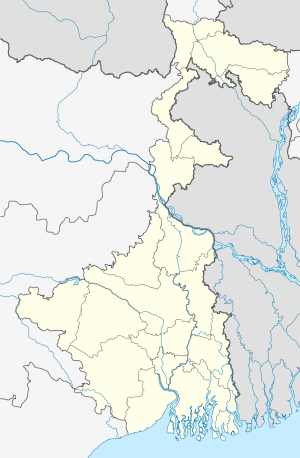Raina II (community development block)
| Raina II | |
|---|---|
| Community development block | |
 Raina II Location in West Bengal | |
| Coordinates: 23°00′49″N 87°51′45″E / 23.01361°N 87.86250°E | |
| Country |
|
| State | West Bengal |
| District | Bardhaman |
| Parliamentary constituency | Bardhaman Purba |
| Assembly constituency | Raina |
| Area | |
| • Total | 85.87 sq mi (222.40 km2) |
| Population (2001) | |
| • Total | 137,458 |
| • Density | 1,600/sq mi (618/km2) |
| Time zone | IST (UTC+5.30) |
| Literacy Rate | 75.17 per cent |
| Website | http://bardhaman.gov.in/ |
Raina II (community development block) (also spelled Rayna and called Rainagar) (Bengali: রায়না II সমষ্টি উন্নয়ন ব্লক) is an administrative division in Bardhaman Sadar South subdivision of Bardhaman district in the Indian state of West Bengal. Madhabdihi police stations serve this block. Headquarters of this block is at Madhabdihi.[1][2]
Geography
Madhabdihi is located at 23°00′49″N 87°51′45″E / 23.0136910°N 87.8626170°E.
Raina II community development block has an area of 222.40 km2.[2]
Unlike the rest of Bardhaman district, which lies to the north of the Damodar River, the Khandaghosh-Jamalpur-Raina area lies on the alluvial plains between the Damodar on its southern/ eastern side and the Dwarakeswar River. As a result, it has been a flood prone area.[3]
It is from this area that the Mundeswari River originates.[4] The small Ratnela khal also originates in the region and later flows into the Ghia river in Hooghly district.[5]
There is a ferry ghat at Ekalki on the Dwarakeswar river.[6]
Gram panchayats
Gram panchayats of Raina II block/panchayat samiti are: Arui, Barabainan, Gotan, Kaity, Pahalanpur, Painta I, Painta I, Painta II and Uchalan.[7]
History
Movements
In 1933, independence activist Dasarathi Tah was involved in Swadeshi dacoities in Meral, Mirzapur and Bogra in the area.[8] Damodar floods wrought havoc in the area and Dasarathi Tah initiated the ‘Nakrah hana embankment movement’ and even published a weekly newspaper named Damodar to focus on the problems faced by the people.[9] In 1948, Raina witnessed the ‘Tebhaga movement’, where sharecroppers demanded a higher share of the crops they grew. The movement was led by Benoy Choudhury and Bipadtaran Roy.[10]
Demographics
As per 2001 census, Raina II block had a total population of 137,458, out of which 70,945 were males and 66,513 were females. Raina II block registered a population growth of 12.24 per cent during the 1991-2001 decade. Decadal growth for Bardhaman district was 14.36 per cent.[2] Decadal growth in West Bengal was 17.84 per cent.[11]
Scheduled castes at 55,329 formed more than one-third the population. Scheduled tribes numbered 5,644.[12]
Literacy
As per 2001 census, Raina II block had a total literacy of 75.17 per cent for the 6+ age group. While male literacy was 84.18 per cent female literacy was 65.59 per cent. Bardhaman district had a total literacy of 70.18 per cent, male literacy being 78.63 per cent and female literacy being 60.95 per cent.[13]
Education
The Raina area has not lagged behind in education. In 1838, a survey by Adams revealed that there were 190 Sanskrit tols in Bardhaman district. Out of this 13 were in Raina. The same report also mentioned Persian schools in the area.[14] In 1947, at the time of independence there were only three colleges in Bardhaman district – at Bardhaman, Kalna and Asansol. Shyamsundar College at Raina was established in 1948.[15]
External links
References
- ↑ "Contact details of Block Development Officers". Burdwan district. West Bengal Government. Retrieved 2011-09-07.
- 1 2 3 "Provisional population totals, West Bengal, Table 4, Barddhaman District". Census of India 2001. Census Commission of India. Retrieved 2011-09-07.
- ↑ Chattopadhyay, Akkori, Bardhaman Jelar Itihas O Lok Sanskriti (History and Folk lore of Bardhaman District.), (Bengali), Vol I, pp.15-18, Radical Impression. ISBN 81-85459-36-3
- ↑ Chattopadhyay, Akkori, p. 33
- ↑ Chattopadhyay, Akkori, p. 36
- ↑ Chattopadhyay, Akkori, p. 716
- ↑ "No. 229 (Sanction)-PN/P/II/1G-5/2005(Pt.II) dated 02.02.09". Allotment No. 5 for five districts – Cooch Behar, Burdwan, Uttar Dinajpur, Hooghly and Bankura. Government of West Bengal - Department of Panchayats & Rural Development. Retrieved 2011-08-26.
- ↑ Chattopadhyay, Akkori, p. 445
- ↑ Chattopadhyay, Akkori, p. 478
- ↑ Chattopadhyay, Akkori, p. 485
- ↑ "Provisional Population Totals, West Bengal. Table 4". Census of India 2001. Census Commission of India. Retrieved 2011-08-26.
- ↑ "TRU for all Districts (SC & ST and Total)". Census 2001. Census Commission of India. Retrieved 2008-08-26.
- ↑ "Provisional population totals, West Bengal, Table 5, Bardhaman District". Census of India 2001. Census Commission of India. Retrieved 2011-08-26.
- ↑ Chattopadhyay, Akkori, p. 547
- ↑ Chattopadhyay, Akkori, pp560-561